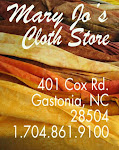Original Article: Our State Magazine, August 2015 Edition (http://www.ourstate.com/)
_____________________________________________
A bit of advice if you venture into Mary Jo’s Cloth Store in Gastonia for a specific item - a button, perhaps, or a yard of fabric for your summer sewing project: Make a list. The sheer size of the store - 32,000 square feet and so humble in its decor that the word warehouse glorifies it - is so staggering that you may be momentarily stuck with amnesia. Aisle upon aisle of fabric. Rack after rack of zippers and threads. The options seem endless. Metal, coil, invisible, plastic, and open-ended zippers line up, eight shades of pink melding into coral on one end and red on the other. Survey the store’s sections: quilting, home “dec,” bridal materials, three walls devoted to trim and ribbon in every conceivable width and color. You recognize the sensation that’s been tickling your mind: abundance. No matter why you came to the store in the first place, you have the comforting feeling that, inside Mary Jo’s, you’ll never run out of anything you could possibly need or want.
Nowhere is that joy of abundance more evident than in one of the most publicized photographs of the store’s founder, Mary Jo Cloninger. Photographed from above, she rests atop bolts of cloth, one arm encircling her head as if she were on a luxurious mattress. That joy, and her more than 60 years in the business, earned her the unofficial title of Fabric Queen.
In 1951, when Mary Jo established her business in the back of her father’s grocery store, her clientele was the stay-at-home mother on a budget. “She kept her markdown low to keep it affordable,” says Thomas Cloninger, Mary Jo’s son and current CEO and CFO. She didn’t advertise. And, adds Thomas, “she never looked at a balance sheet.”
As the business grew, it overtook her father’s commercial space, and Mary Jo moved the shop to its own separate locale down the road in Dallas, and finally to Gaston Mall. All the while, Mary Jo’s continued to cater to families, especially their weddings.
Back in the ‘60s and ‘70s, when the store carried 25 to 30 colors of satin, in would come what Betty Cloninger, buying manager and Thomas’s wife, calls “the tribe”: the bride; her mother; her grandmother; and a slew of bridesmaids, aunts, and cousins. In one intense shopping spree, they bought everything necessary to make all of their dresses and turn themselves out as an ensemble by virtue of their coordinating clothing.
 |
| Proof that the love of fabric is a family affair: Thomas Cloninger with his mother, the matriarch and namesake of Mary Jo’s Cloth Store. |
Nowadays, the bridal inventory has shrunk, an index to the fabric business at large. Pre-recession mill runs of 2,000 and 2,500 yards or more of individual fabrics are now reduced to as few as 500 yards. If Betty wants some of that yardage, she must express interest as far as nine months in advance. Chances are it’s “one run and done.” No manufacturer wants to be sitting on thousands, or even hundreds, of unsold yards of fabric.
Despite the shifting conditions, Mary Jo’s has continued to thrive as one of only five or so one-stop suppliers in the nation to designers of theater productions, films, quilting fests, and sumptuously appointed homes. “She was the first big-box store in the industry,” says Thomas of his mother’s enterprise.
Mary Jo has retired now. But the company still honors the characteristics of a family business. The store manager, Jeannie Guffey, has served for 39 years. Guffey’s mother worked here, too, putting in 45 years. Guffey’s granddaughter occasionally fills in. And a handmade sign still hangs above the checkout counter: “Mary Jo's will always be open to serve our customers.” Here, on the packed notions wall, buttons range from timeless pearlescence to checkered racing flags. Kilt pins, tomato pincushions, and wooden darning eggs from an earlier era take their place next to the latest gadgets for hemming and marking and cutting and quilting. Barry Manilow croons “Copacabana” over the sound system. And the fields of cotton roll on as far as the eye can see.
Cynthia Lewis, who teaches Shakespeare and creative nonfiction at Davidson College, regularly publishes nonfiction. She got hooked on Mary Jo’s when, in the 1980s, she began making curtains for her new home.













